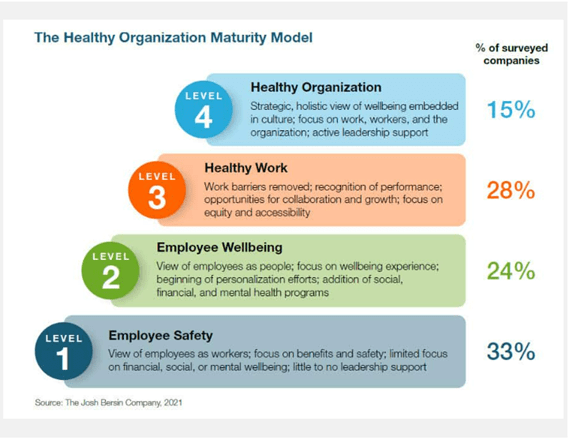The pandemic. Yes, we are still talking about it, but it was a pivotal moment for employee well-being and changes in the workplace. Companies added new perks, benefits, and programs to do two things:
- Promote happier employees
- Better business outcomes
However, are you aware of the hierarchy of needs to be a healthy organization?

From Well-being to The Healthy Organization
Programs and solutions beyond well-being are needed to help everyone in the company to be healthy. Organizations should embrace productivity, growth, and long-term stability-this is where the shift from well-being becomes The Healthy Organization.
Employee well-being has primarily focused on two areas: physical health and safety. While we cannot afford to neglect these areas, there are more: mental well-being, financial fitness, social health and community service, and healthy culture.
What happens when all seven of these elements come together to play? You have the framework of a healthy organization.
The Model of a Healthy Organization
A healthy organization has healthy employees and healthy business practices, thrives under stress, and has financial and business results that others envy. According to The Definitive Guide to Wellbeing: The Healthy Organization, companies that leverage this are:
- 2.7x more likely to delight customers
- 2.2x more likely to exceed financial targets
- 3.2x more likely to engage and retain employees
- 10.8x more likely to have lower rates of absenteeism
- 1.9x more likely to innovate effectively
- 2.8x more likely to adapt well to change
Depending on an organization’s well-being practices, companies fall into the four healthy organization maturity model levels. Companies only operating at level 1 see the least positive impact. Companies that can hit all four levels see the maximum business benefits and are healthy organizations.

Healthy Organization: Hierarchy of Needs
According to the research, only 15% of companies are achieving maximum business value. Yet 57% are at the two lowest levels, primarily focusing on basic employee safety and more traditional well-being benefits.
Level 1: Employee Safety
At the model’s bottom level, companies primarily focus on safety. Companies like Dow Chemical, Chevron, Cemex, and others in the oil and gas and manufacturing industries all rank safety as the highest priority, and it should be. If employees do not feel safe, nothing else can happen.
A Healthy Organization is safe. Safety can take on several meanings. While physical safety is crucial, psychological safety is too. Employees need psychological safety to be vocal, social safety to be quiet or show up late, and leadership safety to feel included, respected, and heard.
Level 2: Employee Well-being
At this level, we see where companies have added wellbeing programs. Most companies have a well-being strategy in place. Organizations like JP Morgan Chase and Workday have well-being ambassadors, business partners, and specialists globally.
Well-being programs often stem from the benefits department, including programs, benefits, and healthcare offerings. They offer fitness, mental health, and resilience programs with check-ins, education, and online assessments. While they add value to the organization, research shows they serve more as recruiting tools than work improvement offerings. Companies love these programs, but there is a greater need to improve productivity and help growth and sustainability.
Level 3: Healthy Work
When people feel they have the right tools, resources, and time, they feel relaxed and productive on the job. How many organizations try mimicking what Google’s workplaces offer their employees? Companies may provide employees with well-being programs, benefits, and nap rooms inside company walls. Still, employees respond: when will they have time to use them?
One of HR’s challenges in level 3 is offering these benefits and programs, yet employees still do not feel genuinely cared for.
At this point, employers need to ask: are workloads too much, are goals clear, and are employees being recognized and rewarded fairly and collaboratively?
Level 4: Healthy Organization
The top tier. At level 4, companies are looking at the leadership model, growth opportunity, and the organization’s overall health from top to bottom. In addition, they are looking at employee retention, mobility, and engagement across the board and identifying when an indicator of the employee experience has fallen behind.
At level 4, companies spend more money on health and well-being, but they are:
- 11 times more likely to have low absenteeism
- 220% more likely to be meeting financial targets
- Twice as likely to be “great places to work”
- 540% more effective at recruiting top people
- Four times more likely to be market leaders and financially top performers in their industry
Conclusion
Research has shown that companies with leadership regularly communicating about health and well-being are four times more likely to outperform other organizations. Healthy organizations also implement practices outside the workplace, like activities that give back to the community, providing employees with paid time off to volunteer, or choosing supply chain partners to demonstrate a commitment to environmental sustainability. Finally, regarding technology and employee well-being, the most impactful technology is simple and transparent.
Axiom Medical can help you transition from level 1 to level 2. By partnering with Axiom Medical and applying our services and solutions, you can be on your way to a healthy organization. Contact us today to find out more!










